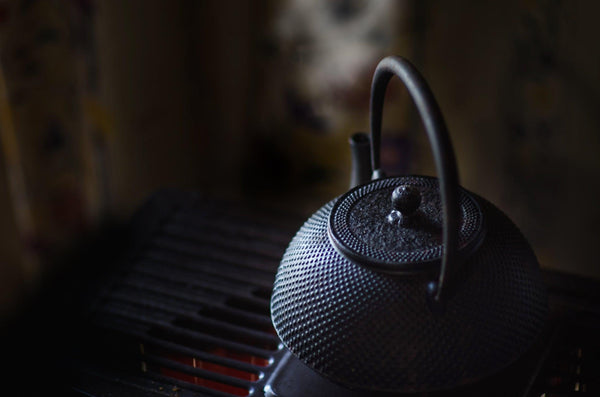
Jump to:
If you have ever attended a tea ceremony or watched one on television, you may have noticed the cast iron kettles with a top handle, a lid, and a pouring spout that are used for boiling the water. The name for this in Japanese is Tetsubin(literally “iron pot”). Although many modern Japanese homes have shifted to using electric kettles and hot water servers, the Tetsubin still has an important place in Japanese culture.
In this article, we shall look at how theTetsubin is used, including its place in the tea ceremony, consider its history, the importance of Tetsubin, and how it differs from other kinds of Japanese kettles. We shall also explore how and where they are made, and the best way to maintain a Tetsubin, rounding off by looking at where they can be purchased and some interesting brands that are worth checking out.
What Is A Tetsubin And How Is It Used?

As described earlier, the Tetsubin is a Japanese cast iron kettle whose primary, well in fact only, purpose is for boiling water, usually to drink tea. The interior of the Tetsubin is left uncoated, so if your pot has an enamel finish it is not a genuine article. When it comes to making tea, you are not going to get very far without boiling water, and in the Japanese art of the chanoyu (tea ceremony), the Tetsubin is traditionally heated over charcoal placed inside a small portable brazier called a Binkake. They vary in size, with the largest holding up to 5 liters of water, and are often elaborately designed. These designs differ from region to region.
History Of The Tetsubin In Japan
The first known reference to the Tetsubin in the literature is in the Genshoku Chado Daijiten, which was an illustrated encyclopedia of Japanese tea published in 1701. This states that the Tetsubin was developed from the Tedorigama, which is a three-legged kettle with a spout and strings attached to the top. It is believed that this refers to the ironware made in Morioka City and Mizusawa City in Iwate Prefecture, in the former Nanbu region.
It seems, however, that the use of Tetsubin only became widespread in Japan around the end of the Edo period to the beginning of the Meiji period(19th century) with the more widespread availability of Sencha green tea, meaning that tea was drunk in more casual settings than being restricted to the tea ceremony, which was a much more formal affair. As Chinese teaware was expensive at that time, craftsmen from the Iwate region started the handcrafting of Tetsubin. These became more popular and later became a common household item.
What Is So Special About Tetsubin

So why has the Tetsubin gained such importance in Japanese culture, particularly in the tea ceremony? A feature of Tetsubin is that the water takes a relatively long time to boil but stays hot for a long time. Whereas in our busy modern lives, we may feel the allure of a high-speed electric kettle to save time, the tea ceremony includes the notions of tranquility and receiving something good as a reward for patience. That is why the long boiling time is considered to be a feature rather than a bug when it comes to Tetsubin.
Another advantage of using cast iron for the materials is the taste. Japanese teas have a great subtlety to them and can be affected by any strong after-taste in the water used. Cast iron is thought to enrich and improve the taste of the water, giving the tea a rounder, less bitter, and thus sweeter taste.
There are also health benefits. Your body uses the mineral iron for growth and development. It is also used to make hemoglobin, a protein in red blood cells that carries oxygen from the lungs to all parts of the body, and myoglobin, a protein that supplies oxygen to the muscles. Iron cannot be made by the body itself and so must be absorbed from external sources such as food, and in this case through water boiled in cast iron.
Lastly, Tetsubin is more durable than ceramic pots, which can crack easily, and, if maintained properly, the same Tetsubin can be passed down and used from generation to generation. This embodies the Japanese principle of Wabi-sabi, in terms of the avoidance of over-consumption, and authenticity and simplicity in everything.
Key Differences With Other Japanese Kettles/Teapots

It is important to know the difference between the Tetsubin and other Japanese-style kettles and teapots. It is thought that inspiration for the Tetsubin shape came from other kettles and teapots prevalent at the time, including the Dobin, and the Yakkan.
The Dobin is a large teapot used for infusing tea. The teapot itself is usually made of ceramic material, and another feature is that the handle is made using a different material than the pot itself, usually bamboo, wicker, or wood. A key difference with the Tetsubin is that whereas the Dobin can be used for both boiling water and brewing tea, you should never brew tea in a Tetsubin.
The Yakkan is similar in design to the Tetsubin but instead of cast iron, the Yakkan is made of copper, and it is said that this gives it a difference in taste to water boiled in a Tetsubin, where bivalent iron is dissolved into the water.
You should also be aware that teapots may also be made from cast iron as is the case with the Tetsukyusu. These are smaller than Tetsubin and are used for brewing tea.
How And Where Are Tetsubin Made?

The Tetsubin is made by casting molten iron into clay or sand mold. Clay molds are commonly used to produce high-quality handmade Tetsubin. For the top of the range Tetsubin, each mold is commonly used only once used only once. In this case, the operation of stamping the pattern on the Tetsubin is done manually for each teapot. For cheaper, mass-produced Tetsubin for everyday use and those for export purposes, sand molds are used to reduce costs.
After the iron has cooled down, the molds are removed and the pots go through a process called “activation”, in which they are baked in a charcoal fire. The fire removes oxygen from the surface of the cast iron and this sets the Tetsubin apart from regular kettles, as the surface may affect the composition of the water when it is boiled. They are then finished using a natural lacquer coating made from the sap of a Urushi tree.
So where in Japan is the Tetsubin made? The Tohoku region of Japan, which includes Iwate Prefecture mentioned earlier, is an area rich in natural iron and is famous for producing Nambu Tekki (Nambu ironware). Characteristically, it utilizes pig iron to create a soft, unique design. Of the two main production cities for Nambu Tekki, Mizusawa produces more everyday kitchenware, whereas Morioka specializes in the higher end of the market. Yamagata and Takaoka are other famous areas for producing Tetsubin.
How To Maintain Your Tetsubin

In this section, we will mention some tips for looking after your Tetsubin so that, hopefully, it can also be used by your great-great-grandchildren.
Firstly, it is important to drain any remaining water from your Tetsubin that will not be used. This is to prevent rusting. After draining the excess water, you should rinse with warm water and then use a dry cloth to dry immediately. After using the cloth, leave your Tetsubin in a well-ventilated place to make sure it is fully dry. As the Tetsubin should only ever contain water, there will never be any need to use soap or detergent, and the use of these should be avoided at all costs.
Another no-no is pouring cold water into the cast iron pot if it has recently had hot water in it or is still hot. This can cause cracking.
Purchasing A Tetsubin
There are many options for purchasing a Tetsubin in Japan. These include some home centers, department stores, and even, weirdly, electronics stores such as Yodobashi Camera. However, given the weight of a Tetsubin, it might be a good idea to avoid lugging it home on the train and purchase it online. Why not make the Japanese Taste website your first port of call, which includes the following items?
Iwachu Tetsubin Arare Patterned Cast Iron Kettle
This is a great example of the Nambu Tekki ironware mentioned previously in this post. It is stamped with a traditional Arare pattern characteristic of the Nambu region, and with a capacity of just under one liter and a weight of 0.9 kg, it is perfect for the water-boiling needs of an individual or a small family.

[callout-1]
Ikenaga Tetu Tetsubin Cast Iron Kettle
If, after checking out the Tetsubin above, you are looking for a slightly different, more minimalist feel, you might like to compare the design of this cast iron kettle from Ikenaga. Although similar in size and weight, it has lost the ornate design and has gone for a more simple look, which is complemented by the teak handle on its lid.

[callout-2]
Iwachu Tetsubin Kettle Baum Japanese Cast Iron Teapot 1.1L
If your preference is for something slightly more ornate than the Ikenaga Tetsubin described above but a little bigger than the first Tetsubin discussed, you might consider this one, also from Iwachu. Also made in the Nambu Tekki style, it holds 1.1 liters of water.

[callout-3]
Tetsubin – The Traditional Japanese Cast Iron Kettle
As discussed, the Tetsubin is not going to be your go-to kettle when you want a quick cupper. Being cast iron, they are heavy, and it takes a long time for water to boil. If you are looking for something very traditionally Japanese that embodies the idea of receiving something good through patience, which in this case in addition to the improved taste of the boiled water includes a nutritional iron boost, the Tetsubin may make an interesting addition to your range of kitchen utensils.
Have you used a Tetsubin? If so, what do you use it for? Have you noticed any difference in the taste of the water? Let us know in the comments.


0 comments